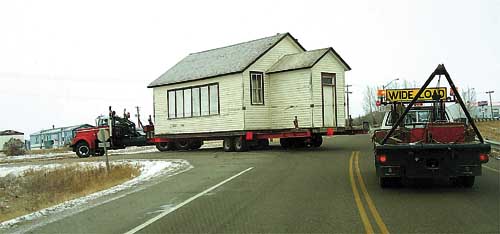One Room Schools Moved to Museum Site
| Two one roomed school houses that served rural students decades ago have found a new home at the site of the proposed Provost and District Museum on the south west edge of town. Western Ridge School was the first to be moved to the site. It was built in 1909 or 1910 on the south west quarter, Sec. 26, Twp.38-R1-W4. Until 1928 the school was known as Franz Joseph, and then changed to Western Ridge. The school has been donated to the museum by the East Central Alberta Catholic Separate Schools Regional Division No. 16, says board member Myron Ganser of Provost. |
|||||||||||||
| Western Ridge, Rosenheim and Hokenheim schools operated for years as a satellite district, operating independent of the public and Catholic system that was in place. They had their own board, buses and tuition agreements to educate their students. Western Ridge was originally a public school but the students were later 100 percent Roman Catholic. In the early 1990s the minister of education in Alberta reduced the number of school boards in the province by amalgamating satellite school districts into the neighbouring operating school district. ECACSSRD had been using the school for storage while STA School in Provost still uses the Western Ridge bus for sports trips. In the Early Furrows history book published in 1977 Dorothy (Ruth) Keller described events when teaching at Western Ridge: “The Christmas concerts were absolutely unbelievable. The children were dismissed at noon to get curled and bathed for the big show. The trustees arrived, put up the tree, decorated it and filled the candy bags. Everything was in readiness for the children when they arrived in the early winter evening after the chores were finished. The girls in crepe paper skirts did intricate drills. There were always humorous plays, a recitation by each tiny tot, then at the very end, the inevitable manger tableau. The gas lantern was removed to the entry to make the scene more ethereal it appeared, but in reality the light was needed to help dress Santa. I remember one wonderful concert, when the candles glowed warmly on the evergreen; a trustee sitting by to insure the tree did not ignite. The children formed a living Christmas tree on the stage and sang Oh Christmas Tree. I asked the parents to join in. I can still hear Pete Gaida’s strong baritone coming through loud and clear with the German version Oh Tannenbaum. Nostalgic tears glistened in his eyes as he remembered Christmases past in his homeland. The glowing candles dimmed for me too when tears of love and gratitude filled my eyes for these fine folks.” Stainsleigh School was named for the man who supplied the first post office in the district north of Hayter. Bill Carter recently told The News that the the Stainsleigh School Community Club bought the school about 50 years ago but there are only about four people left who belong to this club. He said they didn’t want the school to deteriorate any further and are turning over all their funds and the school building to the Provost museum. The school was built in 1911 and closed in 1945. Carter recalls that he started school there in September 1927 and went there for nine years. There was one water pail and one dipper and they all drank from it. The bathroom was outside in the trees. Ruth Carter (later Auburn) was the only person who attended the school and also taught there (for maybe two years). Although markings on the school show 1911, a local history book records that “Rev. Alfred A. Thompson taught at Stainsleigh School from 1910 to 1942.” He began to teach in a tent and then in a room of his small house. In 1909 the district decided to build a school and in 1910 consideration was made to dig a well first. They tried but never did get water (that later came from a neighbour). The first tax rate was 6¢ per acre. The teacher’s salary was $50 per month and teacher Thompson sold a few acres on the corner of his farm for the school site, but he also donated some acres with the understanding that the school would be used as a church. Although many schools were social centres where the people met to dance, he didn’t want the school used for dances. He taught from Kindergarten to Grade 10 in the one room school. In 1912 the school closed for a while because there weren’t enough pupils. The records of one meeting showed that a U.F.A. meeting was to pay 75¢ to use the school while a social evening would be charged out at $1. Both Stainsleigh and Western Ridge schools will be preserved in Provost for future generations to enter and try to imagine what classes and school life were like 90 years ago on the Canadian Prairies.
|
|||||||||||||
